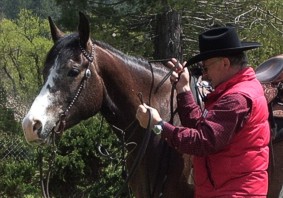|
Art Gallery (Horse Art) |
|
|
|
|
|
||||||
|
6/2/04 The young student, Maverick, is progressing quite well but how well does he stop? Thus far he hears several different methods. The single rein stop is executed by disengaging the hindquarters with the inside leg, sliding the inside hand down the rein to arm's length, grasping the rein and pulling to your hip. Release the inside leg but continue holding the rein until the feet stop AND he becomes soft in the face, release. This method is used early preparing the colt and at times when needed in an emergency. This technique should begin while standing still, this is suppling. Slowly progress to the walk, trot and finally the lope/canter. A second method of single rein stop is done by feeling his face, releasing your legs, sit back slightly and quit riding, push your feet forward and feel him in the face. The volume of feel will vary depending upon how well he hears you and the situation at the moment. All this is done simultaneously while you just tip his nose to one side. Use the outside rein to hold his neck straight and keep his momentum straight forward. This method is usually used to prevent his shoulders from locking up. If he locks his shoulders up, it is easy for him to stop on his front feet. Early preparation will begin from the walk and progress to higher gaits. This technique will cause him to drop down in gate and trot to a stop which is correct. Wait for him to begin responding. Your feel is important to maximize softness and response from him. You will be surprised at how well he will begin to stop softly. The third method is "Slow Hands" and gradually increasing the volume of the cue which determines the final amount of pull. This method does not allow for bend in the body so his body is straight with the direction of momentum. All these methods range in volume from 0-10 with 10 being the loudest when you push your feet forward, lean back, grit your teeth and pull with all your strength. This method may be used early in training. Just remember to use the crescendo each time and be consistent. It won't take him long to start thinking to himself, "I better start stopping before he begins pulling and making me uncomfortable. I'll start as soon as I feel him making contact, because he will release as soon as I begin reacting. & quot; If your horse is thinking this to himself, your consistency is beginning to pay off. There are many variations upon these methods of stopping. Be consistent with each method and wait. Feel, timing and balance are very important and need to be checked continually. The saying & quot; Less is More,& quot; will begin taking a new meaning as your skills continue to improve and his sensitivity to your feel, body language and touch grow. The horse wants to be comfortable, so by making him uncomfortable, he will begin to hear you much earlier. He is then receptive to your suggestions and you will begin observing his softness and lightness. These are only a few techniques I use to stop a horse. There are probably as many different techniques used as there are riders, horses and situations. NO single technique is better than the next. Each rider's interpretation, application, each horse and situation is different. The techniques mentioned are those I use and work best for me in most situations. A rider can easily modify these techniques to best fit his own style and needs. Preparing a horse is interpretation, application and evaluation. |
||||||
|

